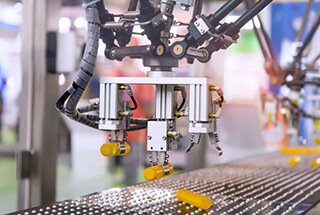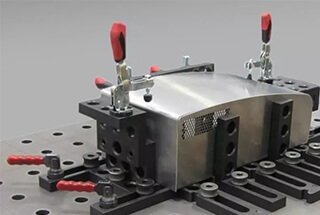
What determines the accuracy of a CNC machine? This question is vital for anyone in the machining industry. In this article, we’ll explore the key factors affecting machining accuracy, such as geometric and positioning accuracy, and the differences between full-closed-loop and semi-closed-loop control systems. You’ll discover how these elements impact the precision of CNC operations and what you can do to enhance it. Dive in to understand how to achieve optimal machining results and ensure your CNC machines perform at their best.

In the machining industry, “machining accuracy” is a common term that is frequently used. It is mentioned multiple times throughout the day, and when conversing with individuals in the industry, machining accuracy is always brought up in discussion.
The question then arises: how can the CNC machine guarantee machining accuracy?

The accuracy of CNC machine tools ultimately depends on the precision of the machine tool itself. This precision includes various factors such as geometric accuracy, positioning accuracy, repeat positioning accuracy, and cutting accuracy.
Geometric accuracy:
It is also known as static accuracy, which comprehensively reflects the geometric errors of the key components of CNC machine tools after assembly.
Positioning accuracy:
This demonstrates the precision of the movement of the machine tool being measured while under the control of the numerical control device. Based on the measured positioning accuracy value, one can determine the optimal accuracy for machining the workpiece in the machine tool’s automated machining process.
Positioning accuracy refers to the difference between the actual position of the part or tool and the standard position (theoretical or ideal position). The smaller the difference, the greater the accuracy.
Ensuring the accuracy of parts processing relies on achieving high positioning accuracy, which is a crucial prerequisite.
Repeat positioning accuracy
This refers to the consistency in position accuracy obtained by repeatedly running the same program code on a CNC machine tool. It also includes the consistency of the results obtained by processing a batch of parts under the same conditions, such as using the same CNC machine tool and operating methods, and with the same part program.
Cutting accuracy:
This is a comprehensive inspection of the geometric and positioning accuracy of the machine tool during cutting operations.
As per the above, CNC machine tools’ accuracy is divided into mechanical and electrical aspects. Mechanical aspects cover the accuracy of the spindle, including run-out and bus bar, the accuracy of the lead screw, fixture accuracy during processing, and the rigidity of the machine tool.
Electrical aspects primarily concern control methods such as semi-closed loop and fully closed loop, feedback and compensation methods, and interpolation accuracy during processing.
Thus, the accuracy of the machine tool is not solely dependent on whether it is fully closed-loop or not.
The motion chain of CNC machine tools includes the following components: CNC device → servo encoder → servo drive → motor → screw → moving parts.
Depending on the installation position of the position detection device, the control can be classified into three types: fully closed-loop control, semi-closed-loop control, and open-loop control.
Fully closed loop control feed servo system
The machine tool is equipped with position detection devices, such as grating rulers and linear induction synchronizers, which are installed on its moving parts, such as workbenches. These devices provide real-time feedback on the position of the moving parts.
After the CNC system processes the information, the state of the machine tool is relayed to the servo motor. The servo motor then automatically compensates for any motion error through the system command.
However, since it involves closed-loop control of the large inertia links of the lead screw, the nut pair, and the machine tool table, it can be more challenging to debug the system in a stable state.
Additionally, installing measuring devices, such as grating rulers and linear induction synchronizers, can be expensive and complicated, which can lead to oscillations.
Therefore, most general machine tools do not use full closed-loop control.
Semi-closed loop control feed servo system
A position detection device is installed at either the end of the drive motor or the end of the screw rod to detect the rotation angle of the screw or servo motor. This helps to indirectly measure the actual position of the machine tool moving parts, which is then sent back to the control system via feedback.
With the advancements in mechanical manufacturing and improvements in the accuracy of speed detection elements and screw pitches, semi-closed-loop CNC machine tools have achieved a fairly high level of feed accuracy.
As a result, most machine tool manufacturers have widely adopted semi-closed-loop CNC systems.
Fully closed loop control system
Position detection devices, such as grating rulers and linear induction synchronizers, have varying levels of accuracy, ranging from ±0.01mm to ±0.003mm. The accuracy level affects the positioning accuracy, and even with full closed-loop control, errors can occur.
Position detection is also affected by thermal properties, specifically thermal deformation. Measuring devices are typically made of non-metallic materials, and the coefficient of thermal expansion varies among the various components of the machine tool.
This is a critical aspect of machine tool accuracy and must be addressed by reducing heat generation during machining to overcome thermal deformation caused by temperature. High-end machine tools utilize various methods, such as screw hollow cooling, guide rail lubrication, and cutting fluid constant temperature cooling to reduce thermal deformation.
The installation of the position detection device is also crucial. In theory, the closer it is to the drive axis (screw pair), the more accurate the measurement. However, due to structural space limitations, there are only two ways to install the grating ruler: near the side of the lead screw or on the outside of the guide rail.
While it is recommended to opt for the first installation method, it can be inconvenient for inspection and maintenance purposes. On the other hand, even though a high-precision grating ruler was selected, it failed to achieve the required accuracy for CNC machine tools.
In the first case, the grating ruler’s installation position is relatively close to the drive axis, but it still maintains a certain distance from it. This distance, coupled with the object’s swing during driving, causes trouble in detecting and controlling the grating ruler.
When the driven object swings towards the grating ruler’s mounting side, it mistakes the moving speed as insufficient during detection, resulting in the system giving an acceleration signal. When the driving object swings to the other side, the grating ruler mistakes the moving speed as too fast during detection, and the system gives a deceleration signal.
Such repeated operations do not enhance the control of the linear coordinate axes of the CNC machine tool but intensify the vibration of the driving object. This leads to a peculiar phenomenon where the fully closed loop is not as good as the semi-closed loop.

Production environmental impact:
Generally, machining factories have harsh environments, where dust and vibration are common phenomena. However, grating scales and linear induction synchronizers are precision components that measure the relative movement position through the reflection of light.
Dust and vibration are the two biggest factors affecting measurement accuracy. Moreover, cutting oil mist and water mist are more serious during machine tool machining, greatly affecting the grating ruler and linear induction synchronizer.
Therefore, if a fully closed-loop control system is used, it is essential to ensure proper installation and sealing and improve the production environment. Otherwise, the accuracy of the new machine tool, which was originally good, will decrease within a year, and the machine will often alarm.
Semi-closed loop control system
As the measuring device is typically installed on the top of the motor or lead screw, it is easier to seal, making environmental requirements unnecessary.
The accuracy error of the semi-closed loop control system primarily depends on the forward and reverse clearance of the screw.
Thanks to advancements in mechanical processing technology, the current manufacturing level of imported lead screws is relatively high. High-precision lead screw pairs practically eliminate forward and reverse clearance.
Furthermore, during the assembly process, the screw pair adopts a double-row reverse ball screw pair, which can fully eliminate forward and reverse clearance.
Many machine tool factories use the pre-stretching method during machine tool assembly to eliminate the impact of thermal deformation on screw drive accuracy.
Therefore, the current semi-closed loop control system can ensure high accuracy of the machine tool.
In summary, it can be observed that in theory, full-closed-loop control can enhance the basic positioning accuracy compared to semi-closed-loop control if external factors are not considered. However, failure to address factors like machine heat, environmental pollution, temperature rise, vibration, and installation may lead to a scenario where the full-closed-loop control performs worse than the semi-closed loop.
Although it might work well in the short term, dust and temperature changes can significantly impact the measurement feedback data of the grating ruler over the long term, thereby reducing its effectiveness.
Furthermore, if there is an issue with the grating ruler, it generates an alarm, which can cause the machine tool to malfunction.

Due to cost considerations and competition, the full-closed-loop control for medium and low-end machine tools has been simplified. As a result, some aspects such as sealing and temperature rise control may not be well guaranteed.
In such cases, simply configuring the grating ruler cannot improve the accuracy of the machine tool, and it can incur significant costs.








